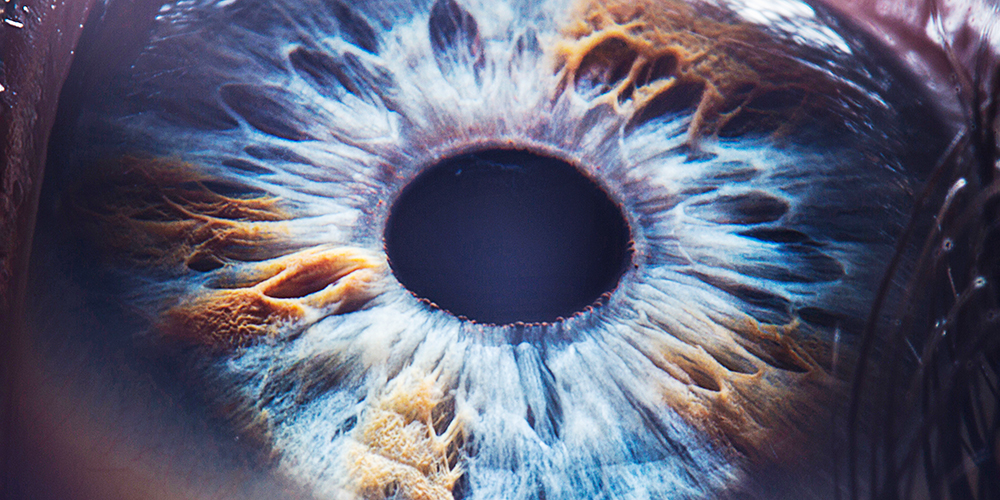Treating glaucoma.
Text: David Herrmann
Among people over 50, one in 50 will suffer from glaucoma, which can lead to a loss of vision if left untreated. The Eye Clinic at the University Hospital Basel has been making major contributions to research into the condition.
Many glaucoma sufferers are unaware that they are going blind. As the condition progresses, retinal ganglion cells become irreversibly damaged and gradually die. A person with glaucoma will typically still see clearly in the center of their visual field whereas their peripheral vision will constantly deteriorate, ultimately leading to total blindness.
While high eye pressure is the main risk factor for glaucoma, two in five sufferers have normal eye pressure. In such cases, the condition is often due to poor blood circulation. This type of glaucoma was the long-standing research focus of Professor Josef Flammer, previous head of the Eye Clinic at the University Hospital Basel. Since Professor Flammer’s retirement six years ago, it is Professor Konstantin Gugleta, senior attending physician at the Eye Clinic, who has been advancing glaucoma research. His work has centered on new treatment approaches.
Ginkgo and antioxidants are effective
Demographic developments mean that glaucoma research is growing in relevance. Swiss society is increasingly aging, and the older a person is, the higher their risk of glaucoma: From two percent of people over 50, the incidence of the condition rises to five to eight percent in people over 70. From a medical perspective, this translates into an urgent demand for new forms of treatment.
Most current approaches to treatment of normalpressure glaucoma use insights and empirical knowledge from alternative medicine. Small-scale clinical studies have found that ginkgo and antioxidants contained in foodstuffs such as dark chocolate, green tea or red wine help protect retinal ganglion cells. Conventional treatments are aimed mainly at lowering eye pressure and regulating blood pressure. The drugs used can have serious side effects, however. As yet, there is no form of treatment that targets the root cause of the disease. With his own research, Gugleta aspires to close this gap and help develop drugs that safeguard retinal ganglion cells.
As a fundamental first step, he is working to understand what causes these cells to die, expecting his findings to provide some initial clues as to how these cells could be kept alive. He is placing great hope in the collaboration with the Institute of Molecular and Clinical Ophthalmology Basel (IOB), a center of excellence that combines fundamental and clinical research.
Down a blind alley and out again
Gugleta is an ophthalmologist with a background in clinical research. In his postdoctoral research, he began trying to find new approaches to glaucoma treatment. At the time, he had high hopes for a then novel procedure for measuring blood flow in the eyes of patients. Using a computer-aided method, blood vessels in the fundus, or back of the eye, were filmed while the eye was being exposed to different stimuli. This made it possible to determine not only how blood circulation in the eye responds to different stimuli but also what long-term effects this has on the optic nerve and consequently on eyesight.
The assumption was that this approach, which involved following patients over a number of years, would prove a link between deteriorating circulation and an increasing loss of nerve cells or visual field. The results were disappointing, however, with statistical analysis revealing no clear correlation between datasets. One explanation for this could be that processes occuring in optic nerve cells are significantly influenced by additional factors.
Focus on growth factors
For Gugleta, the way to overcome this impasse is to collaborate with the IOB, whose technological and human resources offer him entirely new opportunities. It has been known for some time that the survival of any nerve cell, and by implication the optic nerve, depends on so-called growth factors. It could be that growth factors are no longer present in glaucoma patients, causing the cells to die. Gugleta is currently laying the groundwork for a new research project. The plan is to identify and understand these growth processes via a multistage approach involving complex examinations of the relevant biochemical and molecular genetic processes both in the laboratory and in vivo.
First, he plans to investigate how retina-like structures grown from stem cells respond to exposure to different growth factors. Such organoids are being grown in Petri dishes as part of an IOB project. This involves researchers adding different external growth factors and examining how the cells react. The idea is to determine which factors cause cells to die faster and which protect them.
Experiments on pigs’ eyes
The findings will then provide a starting point for the second stage, where pigs’ eyes will be examined. The organs will be collected immediately after slaughter and taken from the slaughterhouse to a laboratory. Here, the challenge is to find effective ways to keep the organ and its cells alive for long enough so that all the necessary tests can be carried out. The retinal ganglion cells contained in the pigs’ eyes will also be tested for the presence of soughtafter growth factors.
While some growth factors are known, the picture is far from complete. For this reason, the findings are to be expanded through in vivo experiments on monkeys. The researchers want to identify the RNA responsible for vital signaling between cells and to determine its protein structure.
The ultimate goal is to develop new drugs that tackle the root cause of glaucoma and protect retinal ganglion cells. In this way, Gugleta hopes to contribute to the treatment of eye diseases and so help people maintain a high quality of life in older age.
More articles in the current issue of UNI NOVA.


